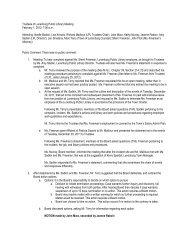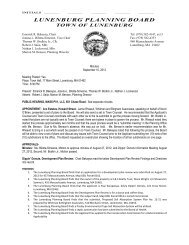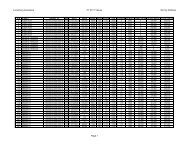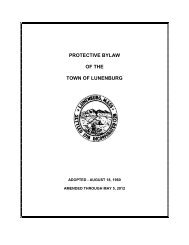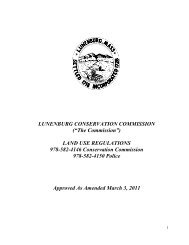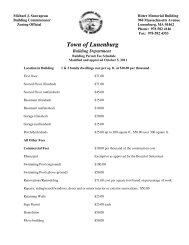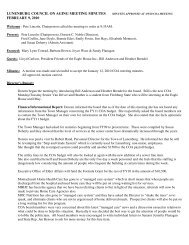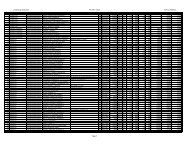T O W N R E P O R T 2007 L U N E N B U R G - Town of Lunenburg
T O W N R E P O R T 2007 L U N E N B U R G - Town of Lunenburg
T O W N R E P O R T 2007 L U N E N B U R G - Town of Lunenburg
- No tags were found...
You also want an ePaper? Increase the reach of your titles
YUMPU automatically turns print PDFs into web optimized ePapers that Google loves.
e) The location <strong>of</strong> existing and proposed utilities,f) The site’s existing and proposed topography with contours at 2 foot intervals,g) The existing site hydrology,h) A description and delineation <strong>of</strong> existing stormwater conveyances, impoundments, and wetlands on or adjacent to the site or intowhich stormwater flows.i) A delineation <strong>of</strong> 100-year flood plains, if applicablej) Estimated high groundwater elevation in areas to be used for stormwater retention, detention, or infiltration.k) The existing and proposed vegetation and ground surfaces with run<strong>of</strong>f coefficient for each,l) A drainage area map showing pre and post construction watershed boundaries, drainage area and stormwater flow paths,m) A description and drawings <strong>of</strong> all components <strong>of</strong> the proposed drainage system including:1) Locations, cross sections, and pr<strong>of</strong>iles, <strong>of</strong> all brooks, streams, drainage swales and their method <strong>of</strong> stabilization,2) All measures for the detention, retention, or infiltration <strong>of</strong> water,3) All measures for the protection <strong>of</strong> water quality,4) The structural details for all components <strong>of</strong> the proposed drainage systems and stormwater management facilities,5) Notes on drawings specifying materials to be used, construction specifications, and typicals, and6) Expected hydrology with supporting calculations.n) Proposed improvements including location <strong>of</strong> buildings or other structures, impervious surfaces, and drainage facilities, if applicable,o) Timing, schedules, and sequence <strong>of</strong> development including clearing, stripping, rough grading, construction, final grading, andvegetative stabilization,p) A maintenance schedule for the period <strong>of</strong> construction, andq) Any other information requested by the SPGA.6.7.5.2. Standards6.7.5.2.1. Projects shall meet the Standards <strong>of</strong> the Massachusetts Stormwater Management Policy, which are as follows:a) No new stormwater conveyances (e.g. outfalls) may discharge untreated stormwater directly to or cause erosion in wetlands or water<strong>of</strong> the Commonwealth.b) Stormwater management systems must be designed so that post-development peak discharges rates do not exceed predevelopmentpeak discharge rates.c) Loss <strong>of</strong> annual recharge to groundwater should be minimized through the use <strong>of</strong> infiltration measures to the maximum extentpracticable. The annual recharge from the post-development site should approximate the annual recharge rate from the predevelopmentor existing site conditions, based on soil types.d) For new development, stormwater management systems must be designed to remove 80% <strong>of</strong> the average annual load (postdevelopment conditions) <strong>of</strong> Total Suspended Solids (TSS). It is presumed that this standard is met when:1) Suitable nonstructural practices for source control and pollution prevention are implemented;2) Stormwater management best management practices (BMPs) are sized to capture the prescribed run<strong>of</strong>f volume; and3) Stormwater management BMPs are maintained as designed.e) Stormwater discharges from areas with higher potential pollutant loads require the use <strong>of</strong> specific stormwater management BMPs.The use <strong>of</strong> infiltration practices without pretreatment is prohibited.f) Stormwater discharges to critical areas must utilize certain stormwater management BMPs approved for critical areas (see MA DEP’sStormwater Management Volume I: Stormwater Policy Handbook). Critical areas are Outstanding Resource Waters (ORWs), cold waterfisheries, and recharge areas for public water supplies.g) Redevelopment <strong>of</strong> previously developed sites must meet the Stormwater Management Standards to the maximum extent practicable.However, if it is not practicable to meet all the standards, new (retr<strong>of</strong>itted or expanded) stormwater management systems must bedesigned to improve existing conditions.h) Erosion and sediment controls must be implemented to prevent impacts during disturbance and construction activities.i) All stormwater management systems must have an operation and maintenance plan to ensure that systems function as designed.j) When one or more <strong>of</strong> the Standards cannot be met, an applicant may demonstrate that an equivalent level <strong>of</strong> environmental protectionwill be provided.6.7.5.3. Project Changes. The permittee, or their agent, shall notify the SPGA in writing <strong>of</strong> any change or alteration <strong>of</strong> a land-disturbingactivity authorized in a Stormwater Management Permit before any change or alteration occurs. If the SPGA determines that the changeor alteration is significant, based on the design standards listed in Section 6.7.5.2. and accepted construction practices, the SPGA mayrequire that an amended Stormwater Management Permit application be filed and a public hearing held. If any change or deviation fromthe Stormwater Management Permit occurs during a project, the SPGA may require the installation or interim measures beforeapproving the change.6.7.6. Operation and Maintenance Plans6.7.6.1. Operation and Maintenance Plan (O&M Plan) is required at the time <strong>of</strong> application for all projects. The maintenance plan shallbe designed to ensure compliance with the Permit, this by-law and that the Massachusetts Surface Water Quality Standards, 314, CMR4.00 are met in all seasons and throughout the life <strong>of</strong> the system. The Operation and Maintenance Plan shall remain on file with theSPGA and shall be an ongoing requirement. The O&M Plan shall include:



